Looking to learn about the axolotl? You’re in the right place! In this ultimate guide, you’ll learn 68 axolotl facts, including: habitat, external gills, lifespan, pet care, range, and nearly eternal youth.
I’ll cover everything you want to know about these adorable little internet sensations. Plus tons of awesome photos and videos!

Table of Contents
68 Axolotl Facts
Is it a bird? Is it a Pokemon? No, it’s an axolotl! Well, it sort of is a pokemon… but nevermind that for now.
Axolotls are ridiculous-looking creatures that have been the butt of many different jokes and memes. They have an enduring place in pop culture, too; they’ve been featured everywhere from Mad Magazine to the original Dune books. They are definitely weird.
Underneath the goofiness, however, there are some surprising things to learn about axolotls.
For example, did you know that they were named after an ancient Aztec god? Were you aware that they can regrow their own limbs? Or that they’re the subject of many different scientific studies to see if their regenerative properties can help us?
There are a lot of fun nuggets like these in a list of axolotl facts. Let’s dive in and learn even more!
1. What does the axolotl look like?
You’ll never mistake the axolotl for anything else. It has an extremely distinctive appearance that’s been inspiring double-takes since the very first explorer found them in a lake and went, “Whaaa?”
For starters, the axolotl has a long, smooth body with thin legs that end in wide-spaced fingers. It can come in a variety of colors, including white, black, pink, yellow and green, and it can be either solid-colored or with a mottled or contrasted appearance.
Speaking of gills, they’re a marvel. There are three on each side of the axolotl’s head, and they extend from the body with an almost Medusa-like appearance – but you won’t turn to stone.
They’re fringed with tiny hairs and gill rakers that help the axolotl move through the water.
Last but not least, the axolotl has a semi-permanent smile that hides a wide gaping maw of a mouth. It opens this mouth to suck up its prey like a vacuum. It looks toothless, but if you peer a little closer, you can make out the tiny tooth-like spots
2. Are Axolotls real?
You can be forgiven for thinking that axolotls are something created by meme enthusiasts. However, axolotls are completely real.
They’re found in the wild in Mexico City (more about this below) and they’re sold as pets internationally.
3. How big is an axolotl?
Axolotls can measure between 6 – 18 inches long.
However, their typical range is 9 – 10 inches, and it’s uncommon for them to reach lengths greater than 12 inches. The bigger specimens tend to be specially bred in captivity.
4. How much does an axolotl weigh?
Axolotls weigh about 10 ounces on average. The longer ones weigh more than the shorter ones, obviously.
5. Is the axolotl an underdeveloped species?
Yes. Axolotls are characterized by their neoteny, which means that they retain their juvenile appearance and behavior into adulthood.
To put it another way, they look like tadpoles even when they’re adults. They don’t lose their gills or dorsal fins as they mature, and they don’t undergo metamorphosis into full-blown salamanders.
They stay in the water, too, which is uncommon for amphibians. Most amphibians are born in the water but develop into adults that live on land, but axolotls stay in the water for their entire lives.
6. How did the axolotl get its name?
“Axolotl” comes from a long-dead Aztec language that was spoken in the Valley of Mexico. It’s considered an extinct language since no one speaks it anymore, but it’s still preserved in ancient texts and art.
Specifically, axolotls get their name from the Aztec god called Xolotl. As the story goes, he was a dog-headed deity that led people into the underworld after they died (like an Aztec grim reaper). Fun guy.
According to legend, there came a time when deities were being sacrificed to the great sun god, so Xolotl transformed himself into an axolotl and hid in the lakes of Mexico.
That’s why the “water” prefix was added to his name.
7. How do you pronounce “axolotl”?
Axolotl is pronounced Ax-oh-lot-ul.
Here’s a video to help:
8. What is the axolotls Latin name?
The scientific name of the axolotl is Ambystoma mexicanum. It literally means “Mexican salamander.”
9. What other names does the axolotl have?
Axolotls are frequently called “Mexican walking fish.”
You’ll probably see this name more than “axolotls” if you’re looking at them in pet stores. They’ve also been called water dogs, water dragons and water monsters.
10. Are axolotls and Mexican walking fish the same thing?
Yep! They’re the exact same thing.
11. What’s a walking fish? Is it a scientific term?
“Walking fish” is a nickname given to many different underwater amphibians that can either walk on land or scuttle along the sandy bottoms of lakes and rivers.
It’s a colloquial term and not any kind of scientific classification.
12. Are axolotls fish or amphibians?
Axolotls are amphibians.
They can get confused for fish since they spend their entire lives underwater and don’t undergo metamorphosis like other salamander species, but they’re still salamanders at the end of the day.
13. Can you turn an axolotl into a regular salamander?
Yes. With the injection of special hormones, scientists have been able to trigger the metamorphosis of axolotls into salamanders.
There have also been reports of pet axolotls becoming salamanders after big stresses or environmental changes.
However, this change isn’t something that everyday pet owners should want or expect, so don’t play around with the genetic makeup of your new tank buddy. If you buy an axolotl, be prepared for it to live and die as an axolotl.
14. Why do axolotls have external gills?
If you’re wondering why axolotls have outies instead of innies, there’s a biological reason for it.
The larger the gills, the more surface area that they have for the necessary gas exchanges that allow them to breathe underwater.
15. Are axolotls friendly?
Axolotls aren’t unfriendly, but it would be a stretch to call them sociable. They’re solitary creatures that keep to themselves.
They don’t have any interest in humans, and they don’t even spend time with their own kind unless they’re mating.
16. Do axolotls bite?
Yes. They’ll bite other axolotls that annoy them or wander into their territory, and they’ll nip at their owner’s fingers during feeding time.
Fortunately, these bites are tiny things that rarely even break the skin. Axolotls lack the dental power to do any real damage, so you have nothing to fear from their bites.
17. Are axolotls dangerous?
To humans, axolotls are a complete non-threat. They can’t hurt you in any significant way.
To other fish, however, axolotls can be quite dangerous. They capture their prey by creating a sucking pressure with their mouths that smaller animals aren’t able to escape, and they violently defend their territory by biting body parts off trespassers.
This defense applies to other axolotls as well. When forced to share a tank, axolotls often become violent and territorial towards one another. They’ll bite the gills, tails, and toes right off their adversaries!
18. Can axolotls smell?
Axolotls have a keen sense of smell. In fact, it’s one of their primary ways of detecting prey and communicating with each other.
They have special sensory organs that allow them to smell things underwater, so whether it’s finding food or following a potential mate, they use their noses a lot.
19. Are axolotls immortal?
No, axolotls aren’t immortal.
They’re able to regenerate lost limbs and organs, and this can sometimes confuse people who associate regenerative abilities with immortal sea creatures like hydras, but axolotls won’t live forever. They have natural lifespans and die of old age when it’s their time.
20. How long do axolotls live?
The average lifespan of an axolotl is around 10 – 15 years. They live longer in captivity than the wild.
21. What eats an axolotl? Predators and Threats
While axolotls are considered one of the top predators in their natural environment, there are a few animals that can take them down.
Their main enemies are birds of prey. Herons and storks can both skim the water and pluck animals from below the surface, so if axolotls venture too close to the shimmering sunlight, they can become vulnerable to birds.
Bigger fish are also a concern. Carps and tilapia weren’t native to the axolotl’s exosystem, but they were introduced to it by farmers, and these fish have come to feed on axolotls whenever they cross paths.
They’ll also compete with axolotls for food, so they’re a double blow to their survival.
22. Are axolotls extinct?
You probably know this by now, but axolotls aren’t extinct. They are critically endangered in the wild, however.
23. Is the axolotl endangered?
Yes. According to the International Union for the Conservation of Nature (ICUN), the axolotl is considered critically endangered.
Their natural habitat has been downsized to a single lake in Mexico City, and their numbers are dwindling even there.
In 1998, you could find 2,300 salamanders per square mile. By 2014, that number was less than 14 salamanders per square mile.
That means that over 16 years, there’s been a decrease of 2,286 wild axolotls per square mile.
How long before they’re gone from the wild forever?
24. How many axolotls are left in the wild?
It’s estimated that there are less than 1,500 axolotls remaining in the wild.
There are plenty more in laboratories and pet stores, but these are all captive-bred, and it’s a very real possibility that they might become the only axolotls in the world someday.
25. Why is the axolotl endangered?
There are a few reasons for the steep decline of the axolotl:
- They used to be found in two lakes, Lake Xochimilco and Lake Chalco, but Lake Chalco was drained in the 1980s because of flooding fears. This means that native, wild-born axolotls are exclusively bred in just one lake in the entire world.
- Pollution has increased everywhere, and Lake Xochimilco isn’t immune to it. In fact, since it has lots of small rivers and channels that feed into it, Lake Xochimilco can be polluted by people hundreds of miles away.
- The population of Mexico City has really swelled in recent decades. Not only does this lead to more garbage and chemical waste, but it also results in accidents like farmers introducing predatory fish to local ecosystems.
- Humans, in general, have been a bad thing for the axolotl. Between roasting them as snacks and selling them as pets, people have put a huge dent in axolotl populations.
26. What is being done to save the axolotl?
In mexico, they have protected areas and they are trying to repopulate the axolotl in the wild.
The video below explains it well:
27. What do axolotls eat?
In the wild, axolotls have a diet of worms, insects, tadpoles, crustaceans, and small fish. In captivity, they can be fed worms, shrimp, fish pellets and strips of beef and liver.
The most important thing is the size of their meal. Since they don’t have fully-developed teeth, axolotls can’t really chew their food. Whether it’s a tadpole in the lake or a bloodworm in an aquarium, they have to swallow their meal whole.
28. How do axolotls hunt?
Axolotls hunt their prey through sensory organs located in their gills and fins.
They have poor vision, so rather than relying on their ability to see what’s around them, they react to things like movement and pressure in the water.
Once they’ve located a snack, they’ll open their mouths and suck in their prey like a vacuum.
The force of the suction is too strong for the other, smaller animal to resist, so they get gulped in and swallowed whole.
29. Can axolotls eat wax worms?
No. Don’t feed wax worms to your axolotl!
Wax worms aren’t real worms at all; they’re the wiggly little larvae of wax moths, and they can’t be digested by your axolotl the way that actual worms can.
In a best-case scenario, your axolotl will pass the undigested wax worm through their system. In a worst-case scenario, the wax worm will cause a blockage in your axolotl’s digestive tract that can lead to illness and even death.
It’s better to be safe than sorry. Avoid wax worms with your axolotls.
30. Do axolotls have any uses to humans?
Yes. Axolotls are considered model organisms, and as such, they’re used in all kinds of medical and scientific research.
- They can regrow limbs and accept organ transplants from other salamanders, so they’re closely studied for their adaptive and regenerative abilities. Maybe someday axolotl genes could be used to help us!
- They have neural tubes in their brains that are a lot like humans, and these tubes can be tested and analyzed without bringing human subjects into the research.
- They’re very useful to heart defect studies since they have a rare gene that allows embryos to survive to the hatching stage even without heart function. This allows scientists to observe heart defects at every stage of development.
31. How do axolotls communicate?
Axolotls can communicate with each other, but they don’t use calls or howls like other animals. Instead, they secrete chemical trails than other members of their species can follow.
This is most often observed during mating season. When they aren’t breeding, the solitary axolotls don’t really have a reason to talk to each other.
32. Do axolotls mate for life?
It isn’t known whether axolotls mate for life, but it’s unlikely. Salamanders in captivity show no particular preferences in mates.
They’ll breed with the same partners if they’re the only ones available, but they won’t show any distress or preference if new partners show up.
33. When is the breeding season for axolotls?
In the wild, axolotls breed during late winter and early spring.
In captivity, they can be encouraged to breed by cooling the temperature of their water and making them think that it’s a seasonal change.
34. How do axolotls breed?
Axolotls are unusual in the sense that they don’t mate like most animals.
When they want to reproduce, the male will lay sperm packets that are picked up by the female, and she’ll become pregnant with no real contact from her partner.
35. Are there any mating rituals between male and female axolotls?
Yes. When a male axolotl is interested in a female, he’ll deposit sperm packets on the ground and try to lead, wiggle, push, nudge and coax her towards them.
If the female wants to accept them, she’ll position her body and take them in; if she doesn’t, she’ll repeatedly swim away from the male until he gets the message.
This is often called the “mating dance” of the axolotl, and it can last for hours with the male producing multiple sperm packets and the female picking and choosing which ones to accept.
36. How many babies do axolotls have?
Are you ready for this? Axolotls can lay up to 1,100 eggs at a time.
Most of them won’t survive to the hatching stage, but the large quantity of eggs can still result in hundreds of births per breeding cycle.
37. What are young axolotls like?
Since they’re a neotenic species (retaining juvenile features in adulthood, i.e looking like babies forever), young axolotls are miniature versions of older ones.
There are no real differences except for size and reproductive ability. They become fully mature within about six months.
38. Can you breed axolotls at home? 6 things to know
It’s pretty easy to breed axolotls. Before you encourage the mating dance, however, you should know that it isn’t always worth the time and expense to do it.
Here are just a few factors that should go into your thought process:
- Your female might lay as many as 1,100 eggs, but you can only fit around 100 – 150 growing babies in a standard-sized tank.
- The eggs will need to be moved into a separate tank as soon as the female is done laying them. Adults aren’t afraid to cannibalize their eggs, so mothers will literally eat their own children if given the opportunity.
- Young axolotls are also cannibals. The strong will eat the weak, especially when they’re hungry, and young axolotls are always hungry.
- You’ll need to feed them at least twice per day, and even then, you should expect to lose a lot of young hatchlings to their siblings.
- Your axolotls will grow to full maturity within six months. This means that they’ll need to be quickly sold or separated into different tanks. Remember: axolotls are solitary creatures, and they don’t always tolerate others in their space.
- Some countries have laws against breeding axolotls. Other countries might allow breeding but disallow selling, which is effectively the same thing unless you plan on raising hundreds of axolotls in your apartment. Be mindful of the rules in your area!
39. Are axolotls loud?
No. Axolotls are very quiet creatures.
They don’t have any songs, barks, growls or mating calls, and even if they did, these noises would be muffled by the fact that they’re constantly underwater.
Your tank’s filtration system will probably make more noise than your axolotl.
40. Do axolotls carry disease?
Axolotls don’t pose any danger to humans. However, they can transmit certain parasites and viruses to other pets.
For example, if your axolotl comes down with the ambystoma tigrinum virus (ATV), steps will need to be taken to ensure that they don’t infect the rest of your fish.
41. Where does the axolotl live?
The axolotl is native to Mexico. Specifically, it’s native to Lake Xochimilco in the southern part of Mexico City. It isn’t found in nature anywhere else in the world.
However, thanks to its popularity as a pet, axolotls can be found in homes around the world.
42. What is the habitat of the axolotl?
The axolotl likes the dark, muddy bottom of Lake Xochimilco.
This area is teeming with plant and animal life to feed them while also providing enough shade and shelter for the axolotl to hide from predators.
They’ll occasionally swim to higher waters for feeding or mate-chasing purposes, but they don’t have any real interest in it.
43. Can you take an axolotl out of water?
This is an ongoing debate among axolotl owners, and both sides have good points.
On one hand, they’re amphibians that possess both gills and lungs, so they can survive short periods of time outside of the water. It isn’t uncommon for handlers to hold them or place them on a tray while cleaning out their tanks. Vets have to take them out of the water during examinations as well.
On the other hand, axolotls have suffocated and died after jumping out of their tanks and stranding themselves out of water for unknown periods of time.
It’s also important to note that they never venture on land while in the wild. It isn’t a natural behavior for them. They definitely prefer the water over the air, and cannot survive out of it for extended periods.
Long story short, while it won’t kill your axolotl to take them out of the water for a selfie, you probably shouldn’t make a habit out of it.
44. Can you touch an axolotl?
Technically, yes, you can touch an axolotl.
But you should be careful. They have a slimy coat that protects them from the elements, and excessive handling can wear away that barrier and leave them vulnerable to illness and injury.
You should also sterilize your hands before touching them and transferring any chemicals from your bare skin to theirs.
45. Do axolotls sleep with their eyes open?
Yes. Axolotls don’t have eyelids, so they never actually close their eyes. They snooze while staring you straight in the face.
46. Do axolotls walk on land?
No, axolotls never leave the water. They’ll walk around the bottom of their lake or aquarium, but that’s about it.
They have no desire to venture on shore, and in an aquarium, they won’t rest on any rocks or decorations that jut outside of the water.
So yes, they could walk on land – they just don’t.
47. Can you eat axolotls?
Yes. Axolotls have been a treat in Mexican cuisine for centuries, and there are manuscripts dating all of the way back to 1787 that talk about their deliciousness: “The axolotl is wholesome to eat, and is of much the same taste with an eel.”
How the axolotl is cooked depends on personal taste.
Some people like to dice them up and tuck them into tamales and rice; others bake them whole and serve them like a regular seafood dish. There’s even a restaurant in Japan that deep-fries axolotls!
48. Do axolotls legs grow back?
Yes. Axolotls are known for their regenerative properties, and if they lose a limb, they can grow it right back.
49. Can axolotls regrow their head?
That’s a tough one. Axolotls can regrow just about anything on their bodies, including limbs, organs and spinal cords.
The spine can be completely crushed, and within a few weeks, the bones will regrow and the nerves will reconnect. The axolotl will walk again.
But, to regrow their whole head seems to be a bit of a stretch and I don’t know of any tests conducted on the subject.
They may be able to fix part of it if it was injured due to impact or a scratch, but the whole head is another matter completely. So for now, I would say no, axolotls can’t regrow their whole head.
50. Can axolotls regrow their brain?
Yes, sort of. This is a bit trickier than regrowing a limb, and it’s believed that most of their regenerative properties are centered around the front portion of the brain called the telencephalon.
They might not be able to regenerate other parts of the brain, or that regeneration might not be as effective as usual. The jury is still out.
51. Can axolotls regrow their limbs indefinitely?
Unknown. Scientists are still researching the full extent of their regenerative powers, but some believe that they can only regrow their limbs around five times.
After that, the cells die, and the loss of limb is permanent.
Others say that they can regenerate the limb anywhere from 50-100 times perfectly. So we don’t really know yet.
52. How do axolotls regrow limbs?
It’s the first thing that people ask when they learn about axolotls regrowing their own heads or hearts. How on earth do they do it?
The simple answer is that their bodies heal differently than other animals. Usually, when a creature loses a limb, the body just grows new skin and scar tissue to cover the wound.
With axolotls, however, the body starts converting nearby cells into stem cells. Stem cells are normally found in human babies and they can be used to create anything the body needs.
For axolotls, this means they can create reproductions of skin, cartilage, veins, bones, and nerve endings. These stem cells are pretty useful little things!
Watch on Business Insider
Why does it happen? Can it be replicated? Can it be used to help us?
These are the million dollar questions surrounding axolotl regeneration. They’re the things that scientists are still trying to figure out. If they ever find answers, you can bet that they’ll be splashed across newspaper headlines everywhere!
53. How long does it take for an axolotl to regenerate?
It depends on the extent of the damage and the health of the salamander in question, but generally speaking, it takes around 30 – 60 days for an axolotl to regenerate their lost body parts or tissue.
54. Are axolotls nocturnal?
Yes. While some captive-bred axolotls might be able to adapt to a daytime schedule, the species is nocturnal in the wild.
They avoid light, have weak eyesight and hunt with their other senses.
55. Where can you find the axolotl?
Does a part of you still think that the axolotl can’t be real? Will you not believe it until you see it?
Well, here’s some good news: Axolotls can be viewed all around the world in zoos, aquariums, wildlife exhibits, and exotic pet stores.
You don’t have to travel to the hidden caves of Mexico City to see them in the flesh. If you want to lay eyes on a real-life axolotl, just find a local exhibit or retailer that breeds them.
56. What pokemon are based on the axolotl?
Yup, there are pokemon inspired by the axolotl. More than one in fact. The one that is typically mentioned is Mudkip, a cute blue and orange Pokemon. The colors may be wrong, but you can definitely see the resemblance.
Second, we have Wooper, also blue and orange. He actually is pretty accurate in his stats: lives in water, buries himself in mud while sleeping, and is coated in a slimy film.
Finally, there’s Chansey. At long last, we have some more realistic colors!
Now, I’m not a pokemon aficionado, don’t kill me, I think real animals are much more interesting.
Anyway, I don’t really know what these little dudes do, or if their powers or whatever are similar to the real-life axolotl. You’ll have to let me know in the comments ;).
Axolotls as Pets
If you’re thinking about owning an axolotl as a pet, here’s what you need to know!
57. Can I have a pet axolotl?
Axolotls are considered an exotic pet species, so check your local laws before buying one.
Some places outright ban them; others might allow them to be owned but not bought or sold. Some places will allow you to buy them, but you’ll need a permit first.
Do your research.
58. It’s legal if I buy an axolotl from a pet store, right?
Not necessarily. Some pet shops have been busted for illegally selling or importing axolotls into their country, and if that happens, it doesn’t matter if you paid good money for your specimen.
It’s still against the rules, and it can still get you in trouble.
59. How much does it cost to buy an axolotl?
Most axolotls are priced between $20 – $70.
Adults cost more than juveniles, and rare colors cost more than common ones. Shipping is also something to consider if you’re ordering them online.
60. What kind of tank or aquarium do I need for my axolotl?
Axolotls can grow between 1 – 2 feet long, so you’ll need a big tank that can support them. Aim for a volume capacity of 10 – 20 gallons.
Height isn’t really important since your axolotl will stick to the bottom of the tank, but they like having room to move around.
61. What fish can I keep with my axolotl?
It isn’t recommended that you keep any fish in your axolotl tank.
Smaller species will be seen as food and promptly gobbled up, and larger species might bully your axolotl by picking at their gills or just stressing them out with their presence. axolotls are solitary creatures by nature, so it won’t bother them at all to be alone in their tanks.
62. Are axolotls easy to take care of?
Yes. While they can be finicky when it comes to things like water temperature, axolotls are quiet, laid-back creatures that you can leave to their own devices, so they aren’t any trouble to own.
They’re actually considered “display pets” like fish and certain reptile species. Rather than interacting with them like cats, dogs, gerbils, and snakes, it’s best to just set up their environment and leave them alone.
63. What temperature do axolotls need?
The ideal temperature for axolotls is between 55°F – 70°F.
They like it cool and dark, so don’t let the temperature get too high, and don’t shine any bright UV lights on them.
64. Can I pick my axolotl up?
This is a controversial question, and we’ve already gone over both sides of the debate, so let’s just say this: axolotls are underwater animals.
Even if you want to take them out of their tank for a spell, don’t leave them breathing oxygen and walking around on land for too long. Return them to their preferred habitat as soon as possible.
65. Can I pet my axolotl?
It’s not a good idea, axolotls aren’t meant to be petted. They might tolerate it, but they won’t actually get anything out of it, and you might make them sick or stressed from the excessive handling.
It’s best to just leave them alone. Leave the petting for puppies.
66. What to feed an axolotl?
Captive axolotls can be fed fish pellets or small strips of meat. If you prefer to give them live prey, they’ll enjoy earthworms, bloodworms and tubifex worms.
67. Can you feed axolotls fish?
Yes, as long as they are small. Some pet owners even treat their axolotls by giving them shrimp and snails.
You just need to be very, very careful with these purchases since axolotls eat by swallowing their prey whole, and if you give them something too big, they might choke on it or die from an unexpected bowel blockage. If you’re at all unsure about the size of the snack, don’t give it to your axolotl.
68. Can I decorate the tank?
This is another controversial subject. Some people believe that it’s good to have sand, rocks, stones or gravel at the bottom of an axolotl tank; it mimics their natural environment, and it gives them something to grip as they walk.
On the other hand, it’s quite common for axolotls to suck up sand and other debris when they’re feeding. This can result in blockages in their digestive tracts that distress or even kill them.
Do some research on the subject if you’re going to buy an axolotl. No one can make tank decisions for you, so it’s worth it to have all of the facts before you choose one thing over another.
The Bottom-Feeding Line
Did you learn anything from these axolotl facts? They’re some of the most curious creatures on the planet, so they’re a lot of fun to research. Still have questions? Post them in the comments and I’ll get back to you as soon as possible!
Drew Haines is an animal enthusiast and travel writer. She loves to share her passion through her writing.
She graduated high school at sixteen and started her own business, Everywhere Wild Media. And she runs Everywhere Wild and JustBirding. She also guest blogs on Storyteller.Travel
She lived in Ecuador for 6 years and explored the Galapagos Islands. Currently based in N.S., Canada.

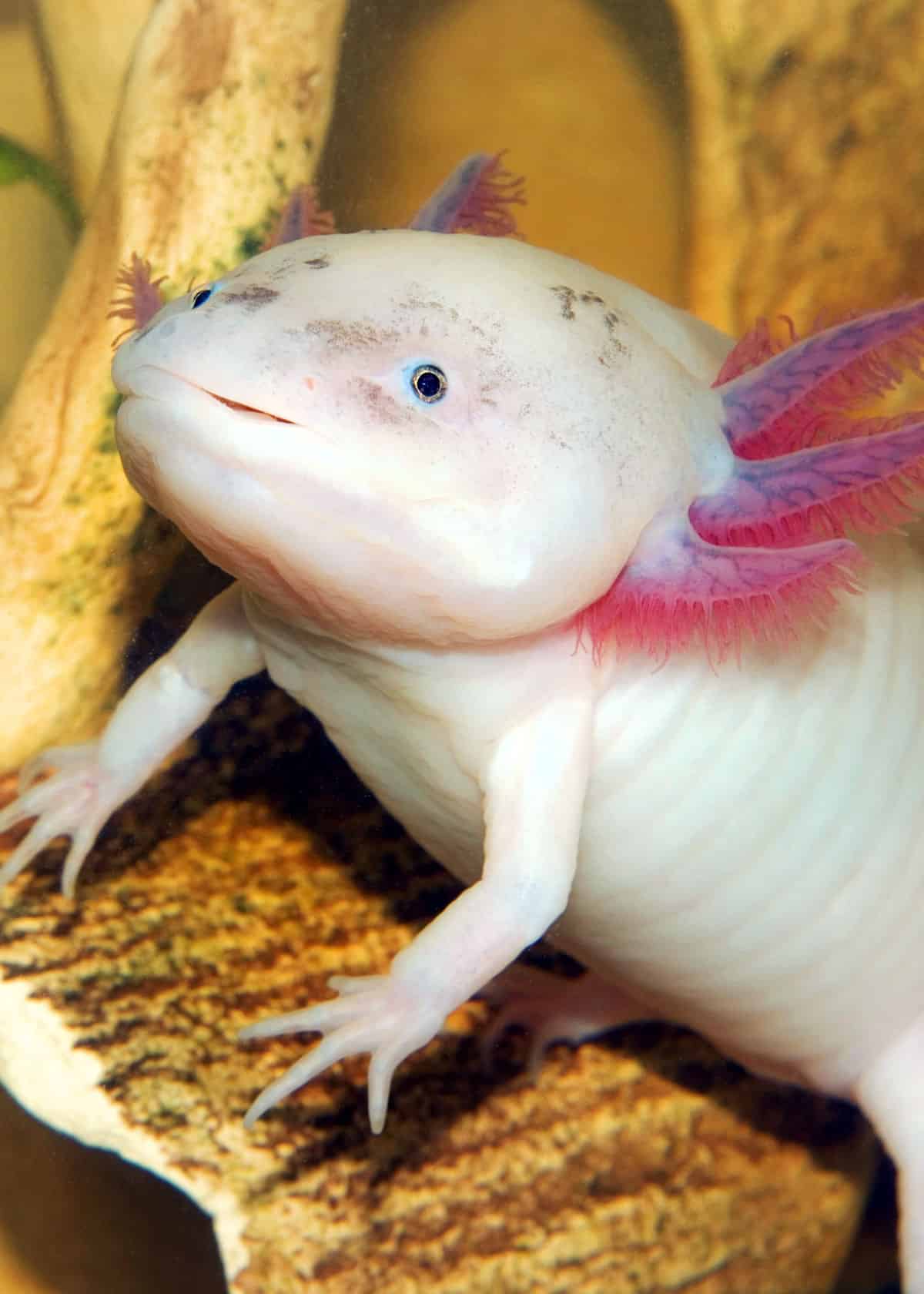

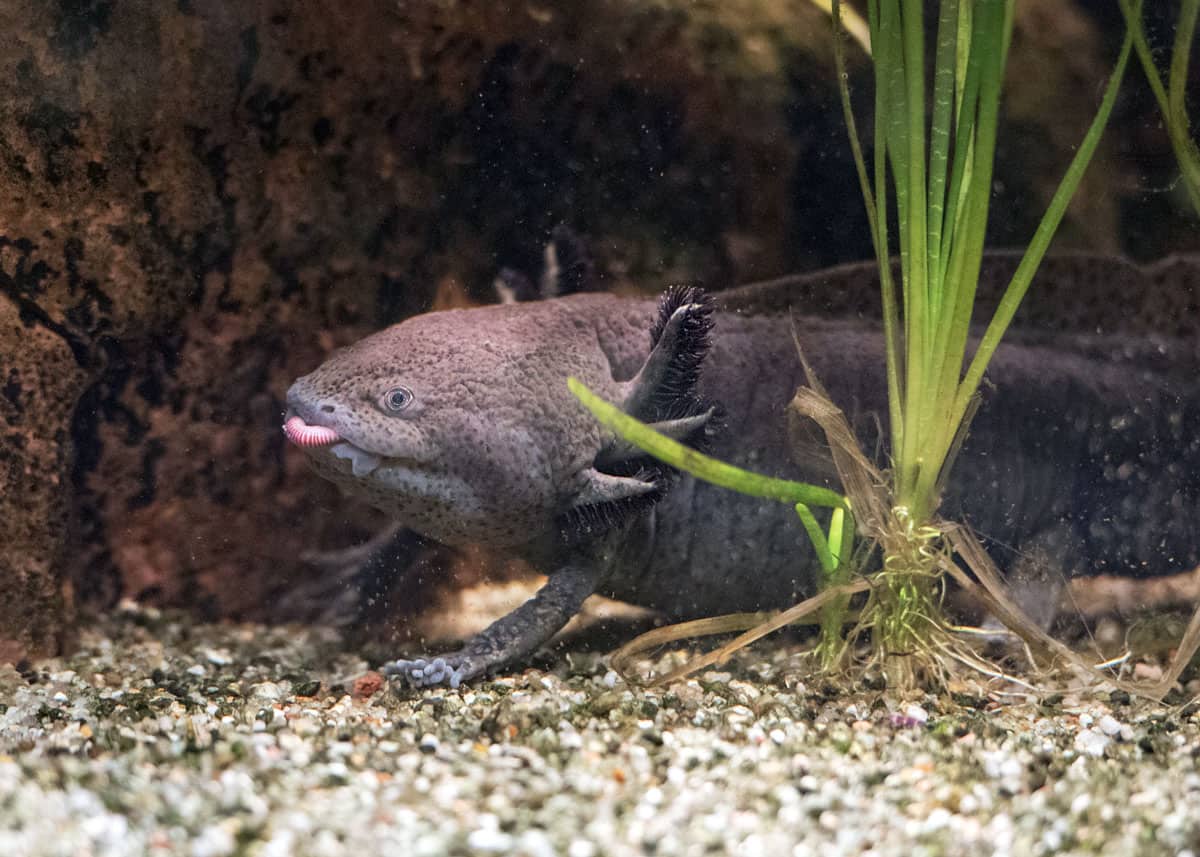
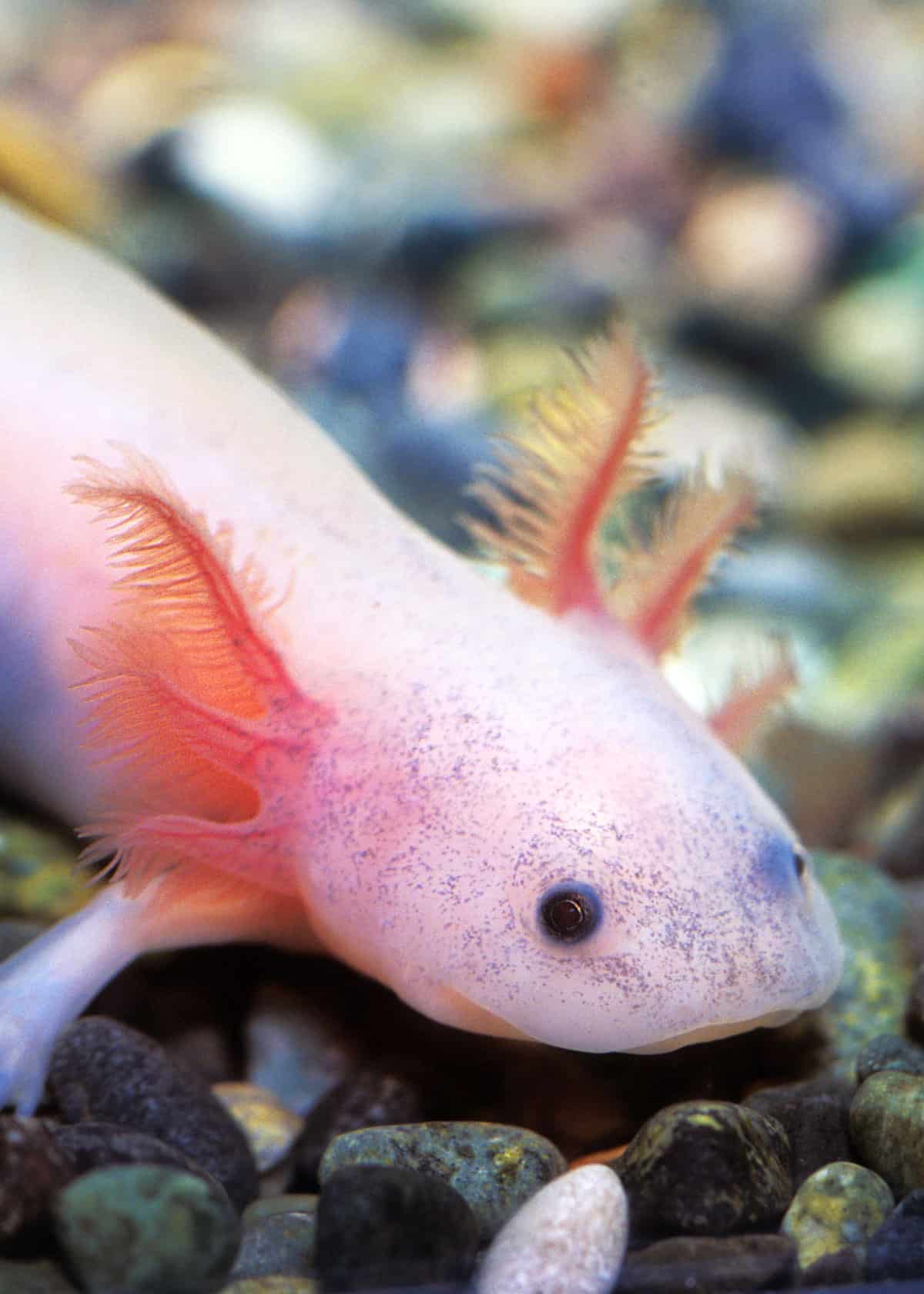
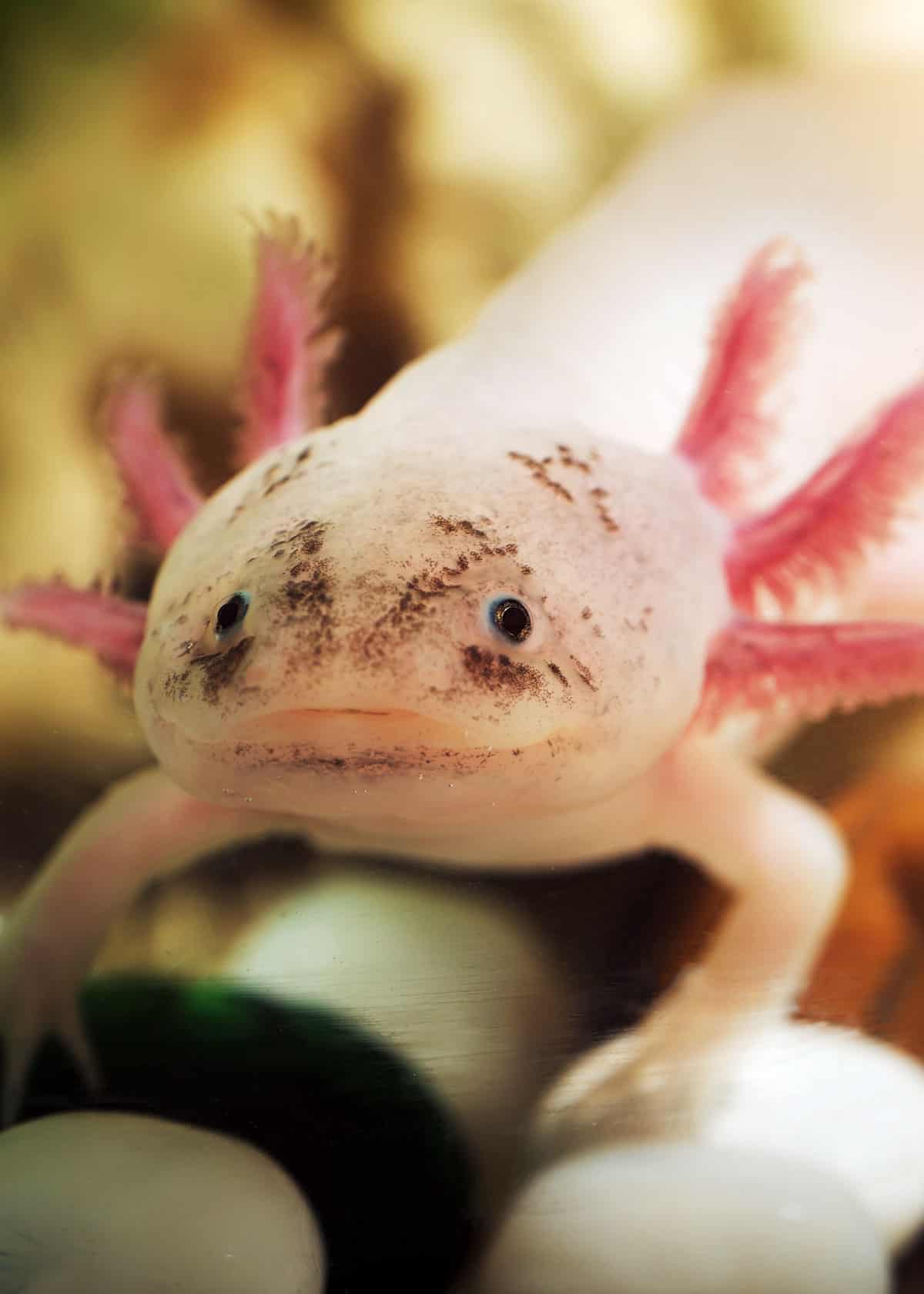

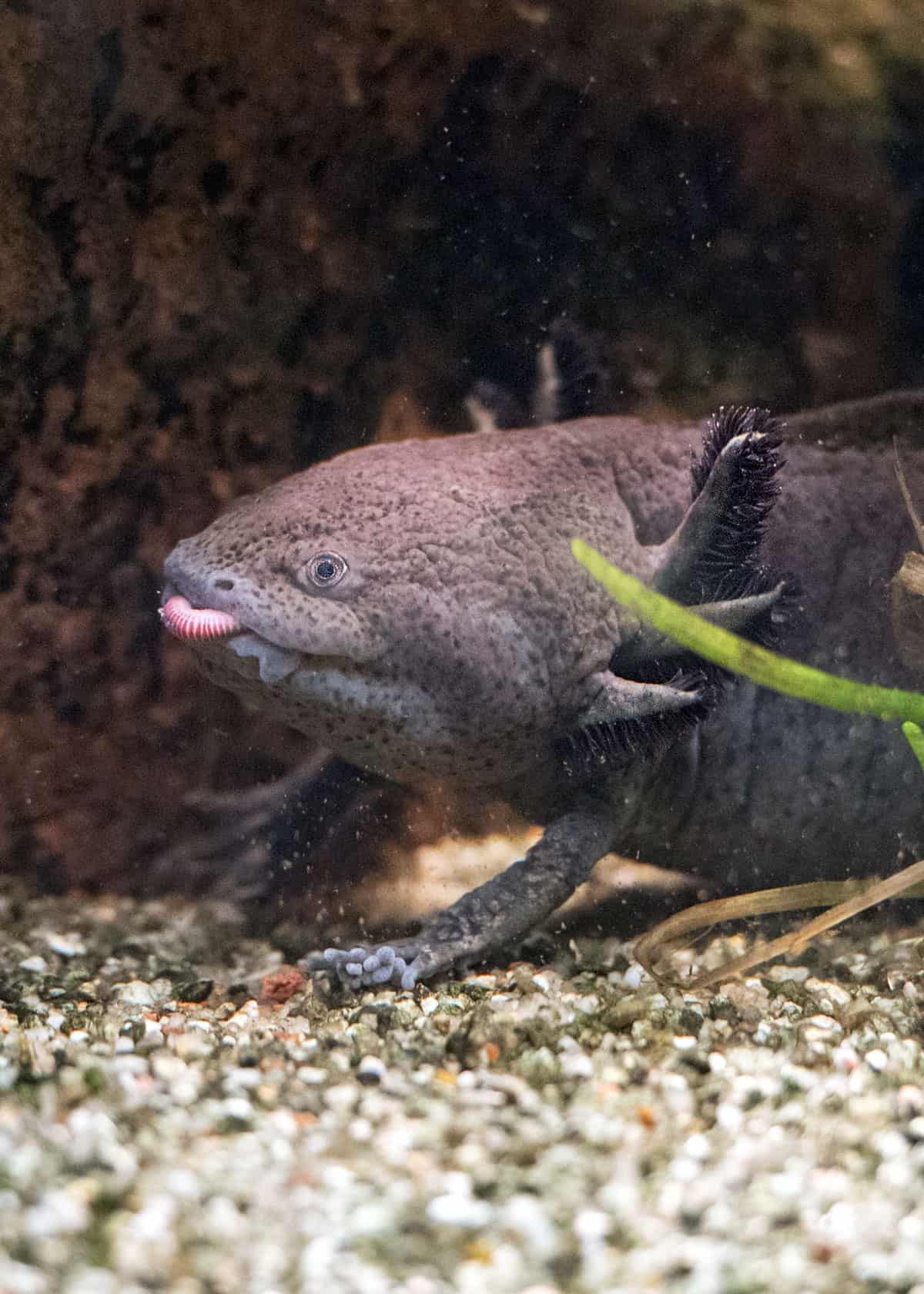
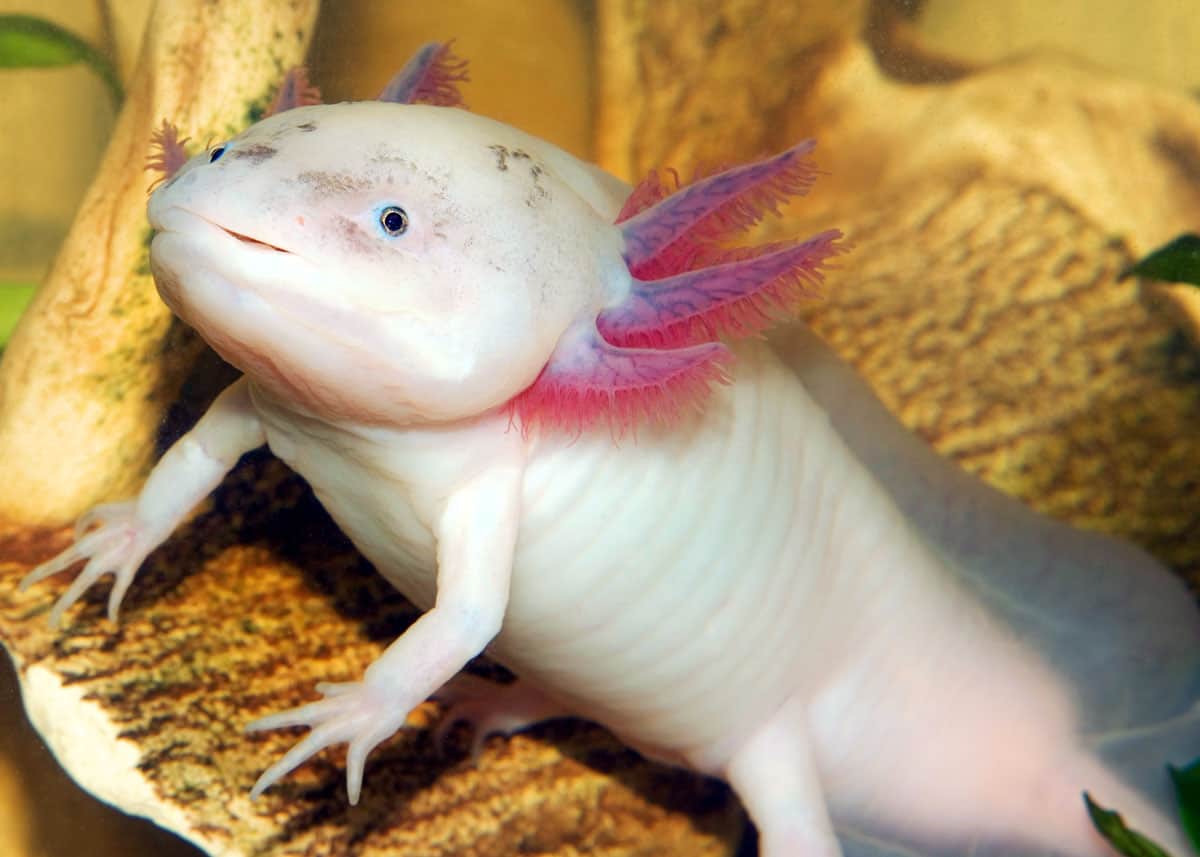
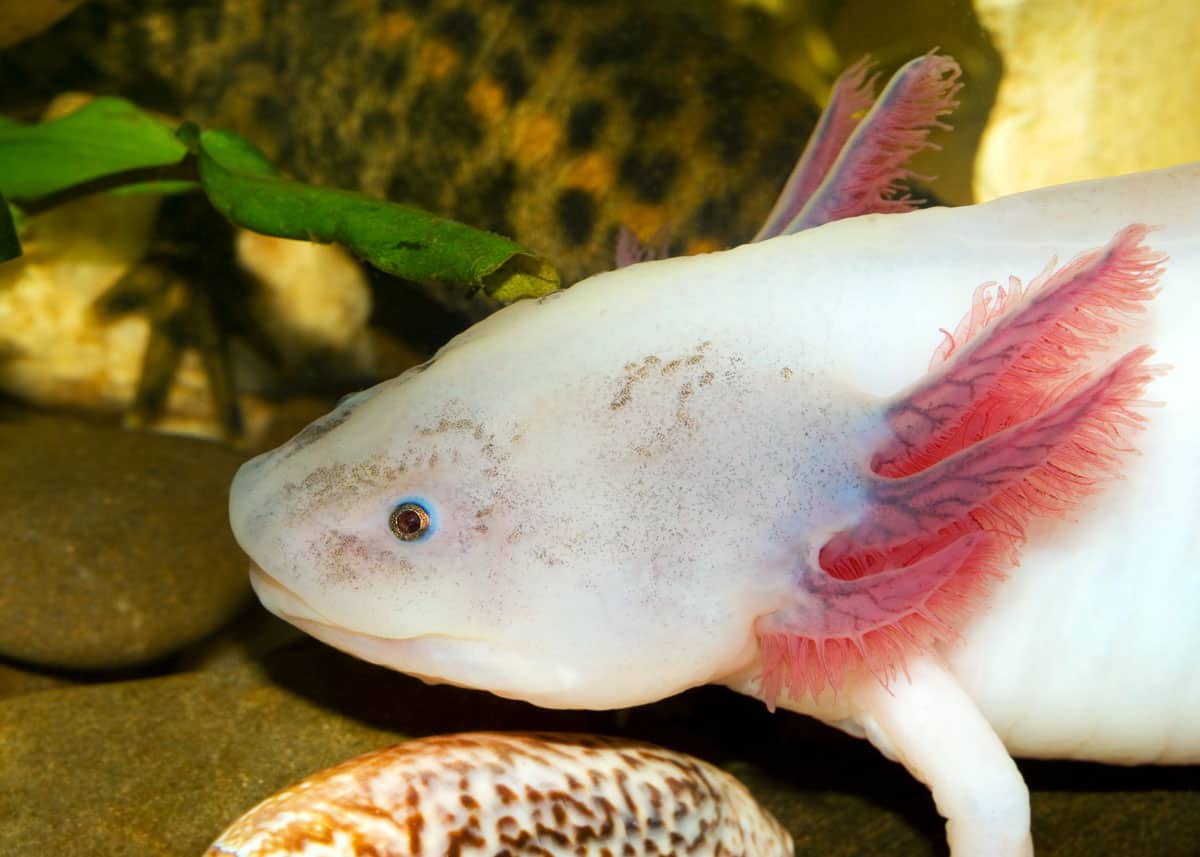
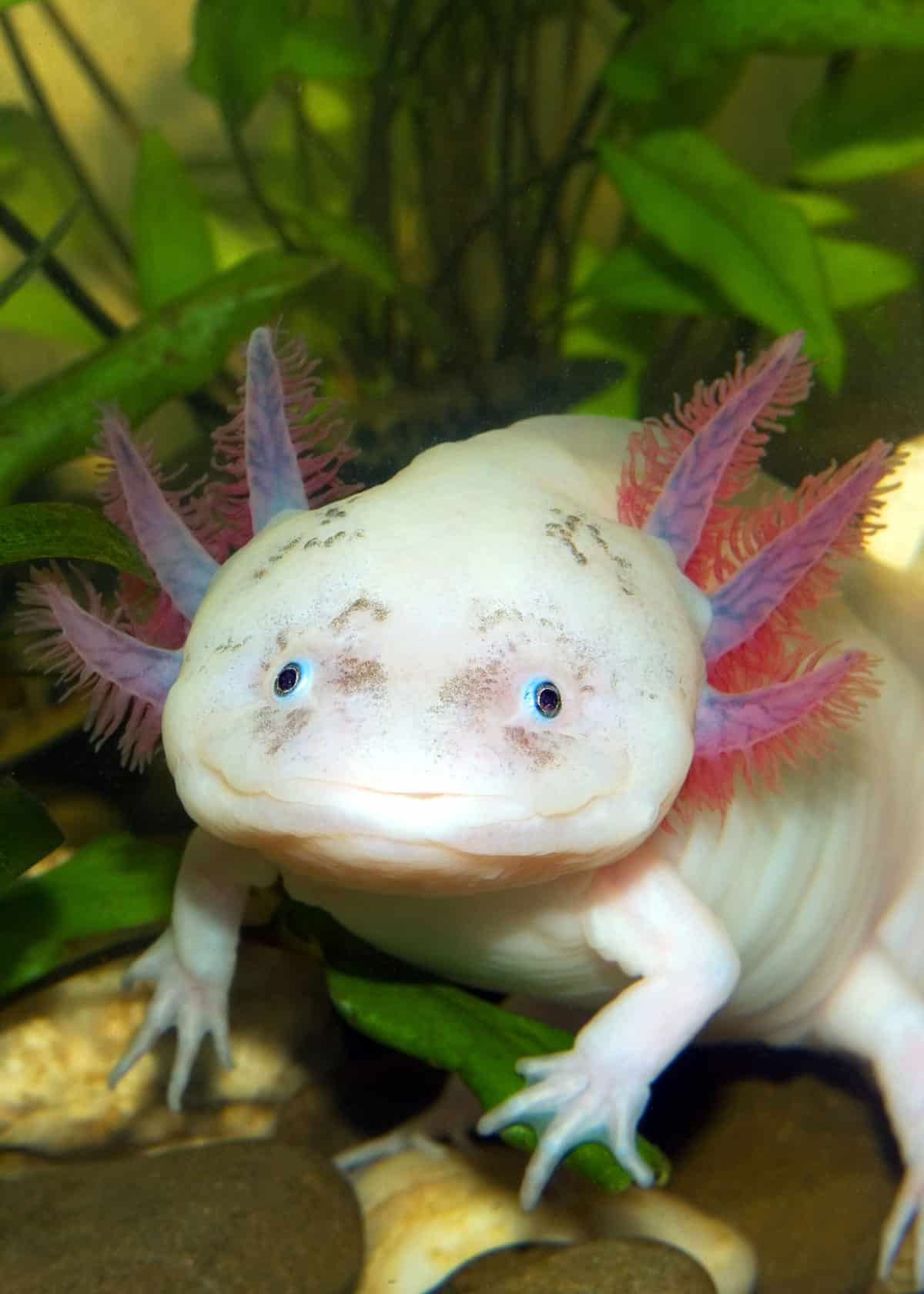
Chloe
Sunday 29th of January 2023
My my! I have really been interested in getting an axolotl into my home! I really love how it had so many cool facts, and it helped me to know more about them too! Thanks so much for this!
Nick N
Wednesday 25th of May 2022
Excellent article. Well written and informative. Thank you for sharing.
Kim Cosgrove
Sunday 15th of May 2022
I loved reading about this as I have two but will probably separate them. Thank you for the information.
Curios
Saturday 14th of May 2022
Do Axolotls leave grease or something on your hand when you pet them ?
Can Axolotls surrvive in the wild somewhere simalar to their natural habitat?
How long exactly can they last out of the water?
And why are they sooooooooooooooooooooooooooooo cuuute!!!!
(last one is a rethorical question)
Dumbo
Saturday 1st of January 2022
Axolotls are the cutest guys ever